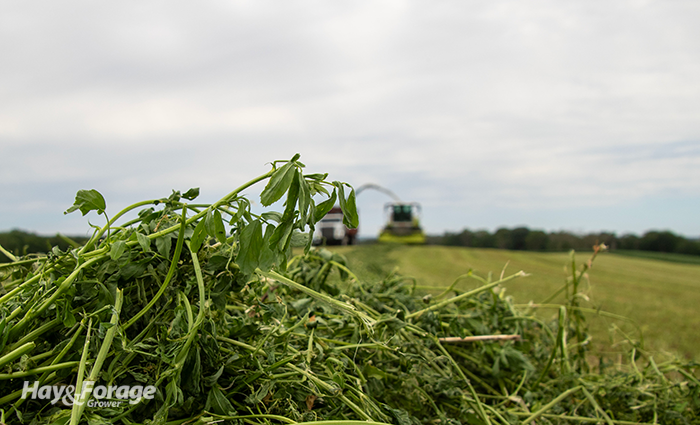
Alfalfa is often touted for its high protein content relative to other forages, making it a valuable component of beef and dairy diets. That protein is subject to degradation at several points throughout the journey from field to feedbunk, though, which creates challenges for capturing this component of forage quality.
In a recent Forage Focus issue from the Midwest Forage Association, Kevin Panke-Buisse and Christina Arther with the U.S. Dairy Forage Research Center discuss several obstacles to preserving protein in alfalfa haylage and share some strategies to mitigate protein loss. These obstacles occur during harvesting, drying, ensiling, and feeding haylage and are attributed to different plant processes at each step of production.
Cutting and drying
Even before harvest, alfalfa protein content is influenced by plant growth stage. For example, less mature forage will have higher protein concentrations, but the authors note proteolytic potential can be higher when harvesting younger plants due to cell wall composition and other physiological factors. That potential declines as plants mature.
“Harvesting between late bud and early bloom can decrease proteolytic potential and lead to better protein preservation; however, this introduces challenges related to digestibility and cutting schedules,” the authors write. “If alfalfa is a primary protein source in the diet, later harvesting may be appropriate to preserve protein, but energy and digestibility will suffer."
Once forage is harvested, plant enzymes will start to break down protein into peptides, amino acids, and nonprotein nitrogen. The longer cut forage dries in the field — and the wetter the plant material is to begin with — the greater the risk of protein degradation. Research shows enzyme activity remains high even after 24 hours of wilting.
“For this reason, dry conditions during and immediately after harvesting and shorter wilting times help decrease protein degradation,” the authors state.
Storage and pH
Quickly and efficiently ensiling haylage will improve the chances of preserving more protein. The faster bags, bunkers, or silos are filled, the sooner anaerobic fermentation can begin, and the more rapidly pH will decline. This drop in pH inhibits proteases from breaking down plant protein; however, alfalfa can put up more of a fight than other species when it comes to ensiling.
“The issue with alfalfa, as opposed to corn or grass silages, is its high buffering capacity due to its protein content, calcium levels, and cell wall composition, causing alfalfa silage pH to be higher,” the authors write. “Consequences of this include extended proteolytic activity in the silo, less inhibition of spoilage organisms, and potential aerobic instability.”
Alfalfa’s inherently higher pH can exacerbate spoilage in storage and at the feedbunk as well, which also negatively affects protein content. This is because a higher pH can impact the type and potency of fermentation acids that are produced during ensiling. For example, the combination of lactic and acetic acids can mitigate yeasts and molds and boost aerobic stability better than lactic acid alone, but acetic acid is more effective at lower pH levels.
Inoculating forage is one way to rapidly reduce pH and inactivate the proteases that break down protein. “In some cases, [inoculation] can be a just-in-case insurance policy. In other cases when dealing with marginal forages or conditions, inoculation is a veritable necessity,” the authors state.
Related to the breakdown of protein in alfalfa haylage is variable amino acid compositions during ensiling. For instance, alanine levels go up, whereas glutamine, arginine, and histidine levels typically go down. Although amino acid composition is distinct from forage protein content, it can influence protein synthesis in the rumen. With that said, the authors suggest there may be opportunities to enhance harvest, storing, and feeding practices that maintain protein in animal diets and preserve limiting amino acids.
“While it’s true alfalfa protein preservation can be an uphill battle, it’s also true that high-quality alfalfa punches above its weight for soil health, cost-efficiency, and forage quality,” the authors conclude. “Even if it is not meeting all of an animal’s protein requirements by itself, alfalfa’s other strengths make higher inclusion of it a great value.”

